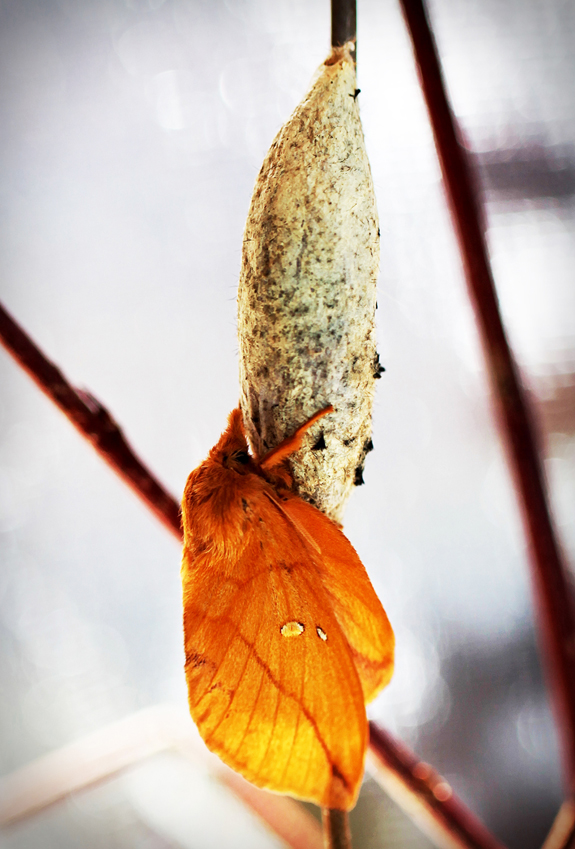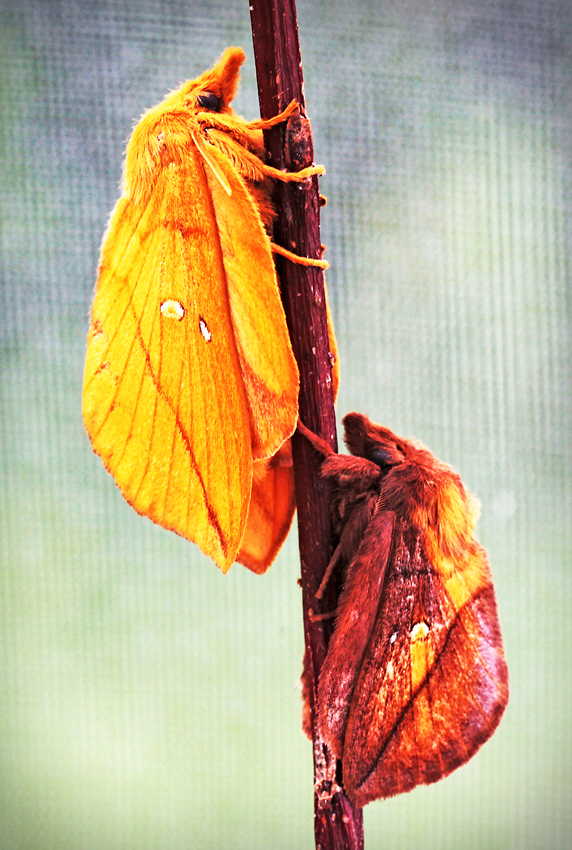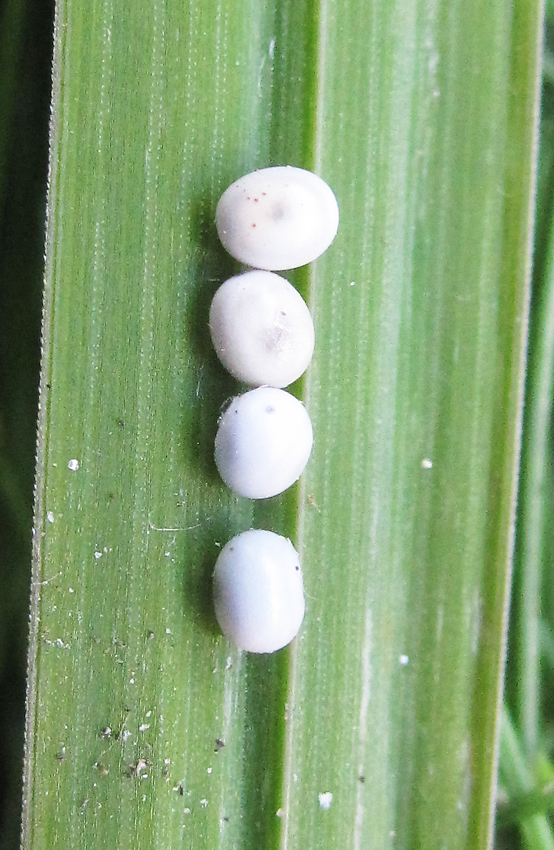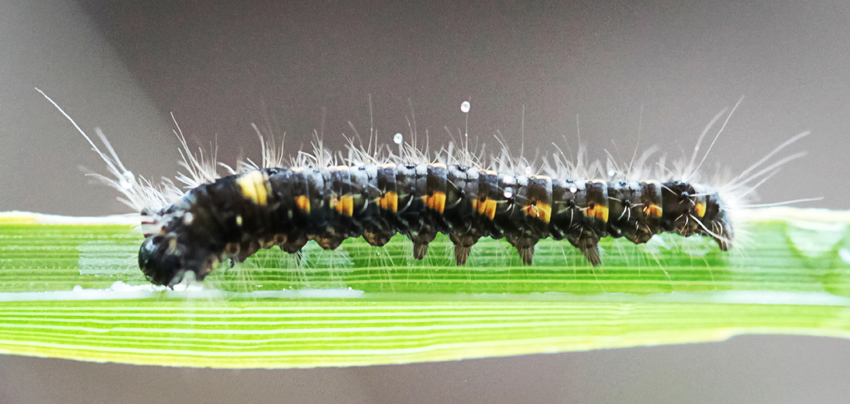DRINKER MOTH - LIFE CYCLE IN IMAGES:
A month or so ago, we were out walking on a track through the bogland beside the Dawros River (see the photo on p108 of "On Your Doorstep: Moths and Butterflies of Connemara); and we spotted a large white cocoon, half way along a stalk of rush. We were unsure of exactly what it was; so we cut the rush carefully, brought it home and placed it carefully in a small netting moth cage - one of the very few bits of dedicated 'moth equipment' we possess.

In due course - some weeks - the white cocoon darkened considerably: a sure sign that emergence is near to hand.
We kept a close eye on it, and sure enough, soon there emerged a beautiful female Drinker moth. We knew it was a female, partly because of the absence of the deeply 'combed' antennae possessed by male Drinkers; and partly because, even as she emerged with wings still wet, the outside of the netting was clustered with excited males!

Well, we opened the cage, and sure enough, by the next morning, at least one lucky male Drinker had reached the female, and was busy at work. The other, less fortunate, males had departed.

We placed a pot of mixed grasses (including 'scutch' and Cock's-foot) into the cage, and some days later we were gratified to spot lots and lots of Drinker eggs: small, white, almost spherical, hard...
And now the eggs have hatched, and our cage and grasses are playing host to multitudes of Drinker caterpillars!
 The Drinker caterpillar hibernates
through the winter; then feeds some more in the spring; then
pupates...and the whole cycle begins again. Drinker adults don't feed or
drink (despite the name, which comes from the caterpillar's habit of
supping morning dew from grass stalks - see the above image, of one of the progeny of the adult above, doing just what its name suggests it should be doing!); so the caterpillars must consume
sufficient energy to sustain the creature through the rest of its life.
The Drinker caterpillar hibernates
through the winter; then feeds some more in the spring; then
pupates...and the whole cycle begins again. Drinker adults don't feed or
drink (despite the name, which comes from the caterpillar's habit of
supping morning dew from grass stalks - see the above image, of one of the progeny of the adult above, doing just what its name suggests it should be doing!); so the caterpillars must consume
sufficient energy to sustain the creature through the rest of its life.
Soon, we'll release them back into the wild, so that they can continue their lives in peace. They will find a place to hibernate in the late autumn, and we hope to see many of them again - as adult Drinker moths - next summer.
And that is the joy of moth-spotting!!
A month or so ago, we were out walking on a track through the bogland beside the Dawros River (see the photo on p108 of "On Your Doorstep: Moths and Butterflies of Connemara); and we spotted a large white cocoon, half way along a stalk of rush. We were unsure of exactly what it was; so we cut the rush carefully, brought it home and placed it carefully in a small netting moth cage - one of the very few bits of dedicated 'moth equipment' we possess.

In due course - some weeks - the white cocoon darkened considerably: a sure sign that emergence is near to hand.
We kept a close eye on it, and sure enough, soon there emerged a beautiful female Drinker moth. We knew it was a female, partly because of the absence of the deeply 'combed' antennae possessed by male Drinkers; and partly because, even as she emerged with wings still wet, the outside of the netting was clustered with excited males!

Well, we opened the cage, and sure enough, by the next morning, at least one lucky male Drinker had reached the female, and was busy at work. The other, less fortunate, males had departed.

We placed a pot of mixed grasses (including 'scutch' and Cock's-foot) into the cage, and some days later we were gratified to spot lots and lots of Drinker eggs: small, white, almost spherical, hard...
And now the eggs have hatched, and our cage and grasses are playing host to multitudes of Drinker caterpillars!
 The Drinker caterpillar hibernates
through the winter; then feeds some more in the spring; then
pupates...and the whole cycle begins again. Drinker adults don't feed or
drink (despite the name, which comes from the caterpillar's habit of
supping morning dew from grass stalks - see the above image, of one of the progeny of the adult above, doing just what its name suggests it should be doing!); so the caterpillars must consume
sufficient energy to sustain the creature through the rest of its life.
The Drinker caterpillar hibernates
through the winter; then feeds some more in the spring; then
pupates...and the whole cycle begins again. Drinker adults don't feed or
drink (despite the name, which comes from the caterpillar's habit of
supping morning dew from grass stalks - see the above image, of one of the progeny of the adult above, doing just what its name suggests it should be doing!); so the caterpillars must consume
sufficient energy to sustain the creature through the rest of its life.Soon, we'll release them back into the wild, so that they can continue their lives in peace. They will find a place to hibernate in the late autumn, and we hope to see many of them again - as adult Drinker moths - next summer.
And that is the joy of moth-spotting!!